Day 1 of a three day long weekend of Early Summer Tours today. It was a foggy start to the day again, but the fog quickly thinned and then gradually lifted to low cloud through the morning and it even brightened up later in the afternoon. Nothing to stop us seeing some good birds!
As we drove round to collect all the group, the Peregrine was back in position again on the church tower, where it had been a couple of weeks ago. So once we had collected everyone, we went back for a look. It was a bit foggy up around the tower, but we had a good look at it through the scope. A nice way to start the day. Several Common Swifts were zooming around over the rooftops in the fog too.
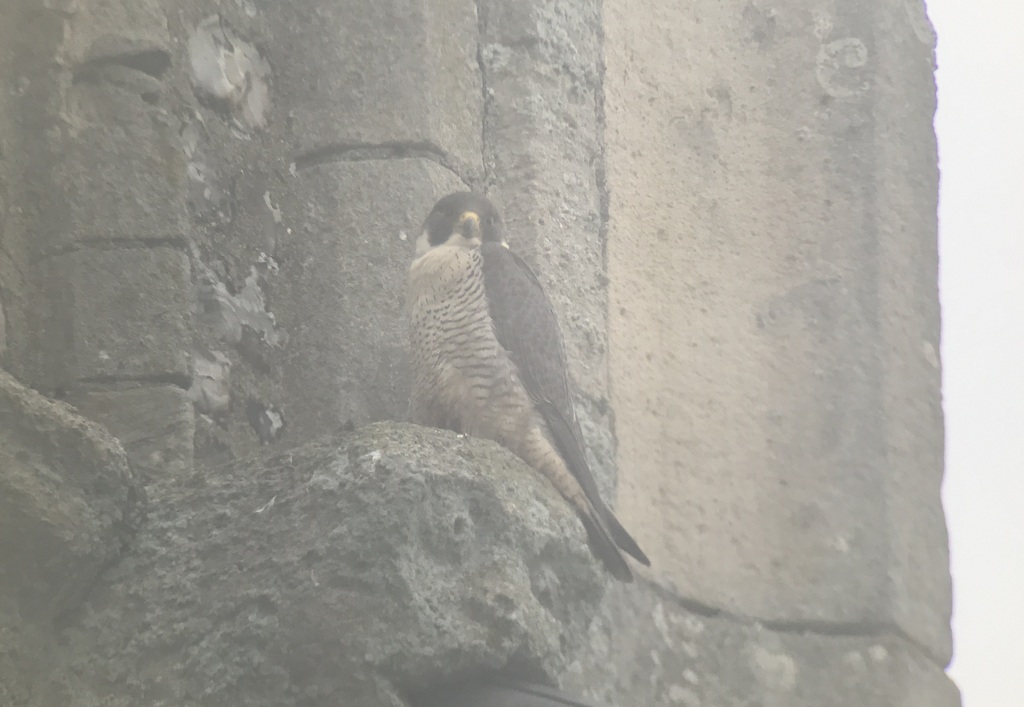
Our first stop was a short drive east along the coast to Stiffkey. There had been a Red-backed Shrike here yesterday and it was reportedly still there first thing this morning, so we fancied a look at that. As we drove past the wet meadow by the road east of the village, we spotted a large white bird in one of the pools in the mist. You cannot stop along the road here, so we parked further up and walked back.
On our way along the footpath, we stopped to scan the newly cultivated strip on the edge of the field nearby. There were a couple of Stock Doves walking round on the ground and a pair of Oystercatchers further back. A Brown Hare was grooming itself, having a good scratch, on the edge. A Lesser Black-backed Gull flew over chased off by a noisy Avocet.

From the corner of the path, we could see the white bird we had spotted on our way past in the car. It was a Spoonbill and it was very busy feeding in the deep water, sweeping its bill from side to side. As we watched it through the scope, we could see that it was colour-ringed and with a bit of effort we managed to read the combination.
The Spoonbill turned out to be one we already knew well – we had been responsible for previous sightings of the very same bird in 2015 and 2016! Originally ringed in the nest in the Netherlands in 2011, it was seen in France and Germany in 2012, back in the Netherlands in 2013-2014, then in Norfolk in 2015 and 2016. It will be interesting to see if it has been seen anywhere else since then.
While we were watching the Spoonbill, a Siskin flew over in the fog, calling. As we made our way back along the footpath, a Common Whitethroat was singing in the hedge. The meadow next to the path was looking stunning, as the poppies are really starting to come into flower now. Two Skylarks flew round just above all the flowers.
As we made our way through the trees and across the road, a Blackcap and a Chiffchaff were singing in the copse. A little further along, a Reed Warbler was singing in a clump of trees – making an interesting change from their usual choice of reeds.
Up on the seawall, we headed west today along the Coastal Path. A family of Shelduck, two adults with 9 shelducklings were swimming around on the channel below. There were a few more Common Whitethroats in the bushes, a pair carrying food and alarm calling as we passed.
Then three Spoonbills suddenly appeared, flying towards us out of the fog, almost overhead. They turned either side of us, one of them swinging back round and down onto the saltmarsh. We had good views of it in the scope, an adult, we could see the yellow-tip to its bill and its bushy nuchal crest, as it fed in the small pools.
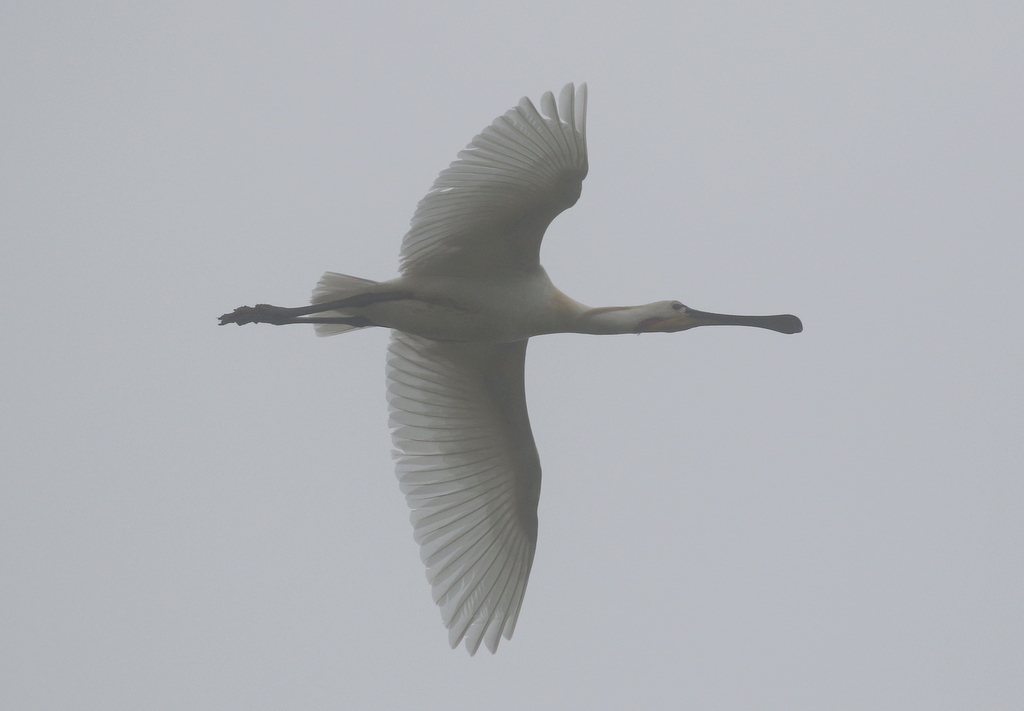
A little further on, we found a small group gathered. Apparently, there had been no sign of the Red-backed Shrike for the last two hours, since it was first reported earlier this morning. We decided to carry on along the path to see what we could find and we had not gone far before we spotted the shrike up in the top of the hedge at the back of the bushes. We had good views of it through the scope, before it dropped down again out of view.
The rest of the crowd arrived, but the Red-backed Shrike stayed down out of view for a while. We could hear a couple of Lesser Whitethroats alarm calling further back along the path, and saw them flitting agitatedly in and out of the hawthorns. We walked back for a closer look to see what was upsetting them and found the Red-backed Shrike again in the top of a hawthorn. It was a bit further back from the path here, and not so disturbed by people walking up and down.

The Red-backed Shrike was a stunning male, with a rusty back, grey crown and black bandit mask, and a delicate pink wash underneath. It showed very well here, and even started singing at one point! Some video of it singing here yesterday can be seen below.
Red-backed Shrikes used to breed commonly in the UK, but declined steadily and finally disappeared in 1987, with just sporadic breeding records since. They are still scarce but regular migrants passing through on their way to or from Scandinavia. There had been a little flurry of records in the last few days, with birds probably drifting off course in the north-easterly winds and fog.
After enjoying great views of the Red-backed Shrike, we headed back along the path. The Spoonbill was still feeding out on the saltmarsh, where we had left it earlier. Back at Stiffkey Fen, we could see a single Little Ringed Plover and plenty of Avocets out on the islands. A pair of Sedge Warblers were going in and out of the nettles below us. A Cuckoo was singing in the poplars at the back.
On our way back to the car, we could hear Bullfinches calling and a Garden Warbler singing. We managed to find one of the Bullfinches feeding on the buds in a large hawthorn the other side of the river, a cracking pink male.
It had been a very productive walk this morning, despite the fog. We made our way round to Cley for an early lunch. A single Greenshank out on Pat’s Pool was just visible over the reeds through the scope, with a couple of Redshank. While we were eating, a Cuckoo flew over the car park and we could hear a Cetti’s Warbler singing in the ditch the other side of the road.
We had been intending to go up to the Heath one morning, but it had been foggy earlier today. The forecast for tomorrow had been for it to be dry and brighter but it had completely changed this morning – now they were forecasting rain tomorrow. It would be nice if they could make up their minds! So we decided to have a go up on the Heath this afternoon.
When we arrived in the car park, we could hear a Willow Warbler singing. We looked up in the direction of the song, and saw it perched high in a birch tree. A Yellowhammer was singing over the other side and we walked across to get a closer look. It was high in another birch and through the scope, we could see its bright canary-yellow head and breast.
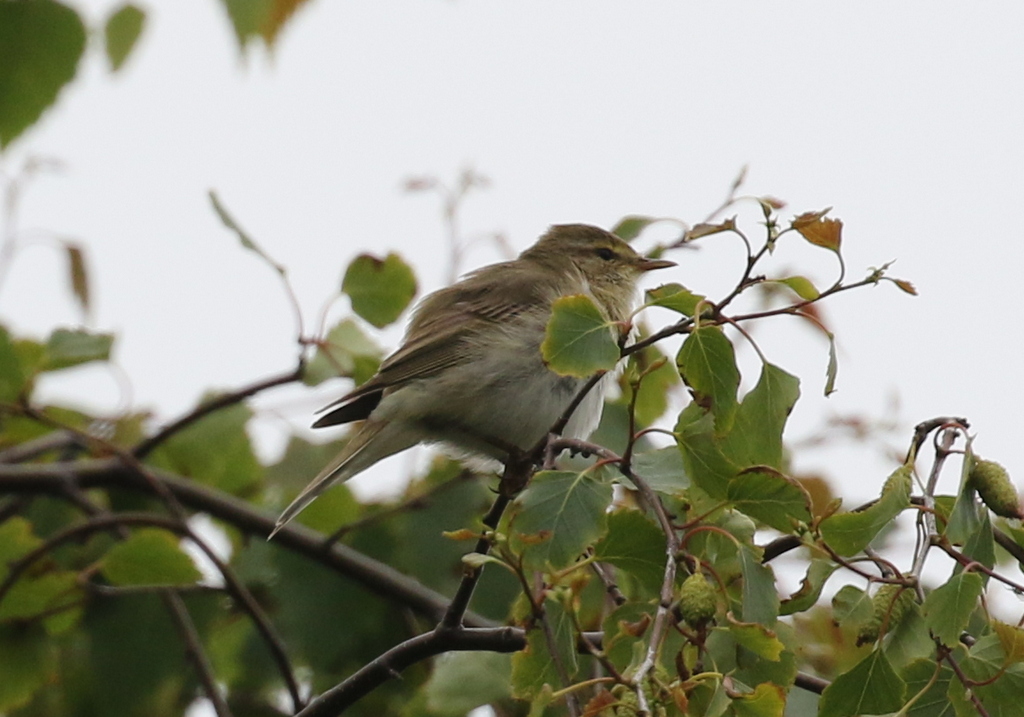
As we walked on across the heath, it was much quieter. There were very few other birds singing, often the way mid-afternoon. A Great Spotted Woodpecker called from some trees inn the distance. We did a circuit round one of the Dartford Warbler territories, but there was no activity here, just a few Linnets.
As we got back to where we had started, we noticed a small dark bird with a long tail zip across between two gorse bushes. Then another flew across the other side. Dartford Warblers! We stood and waited, and at first had tantalising glimpses as they flitted around deep in the heather or flew back and forth.
We gradually realised it was a pair of Dartford Warblers carrying food, back and forth repeatedly from where they were feeding in front of us. A couple of times, they perched up in the top of the gorse and the male stopped briefly to sing at one point, even then performing a song flight over the taller gorse behind us.
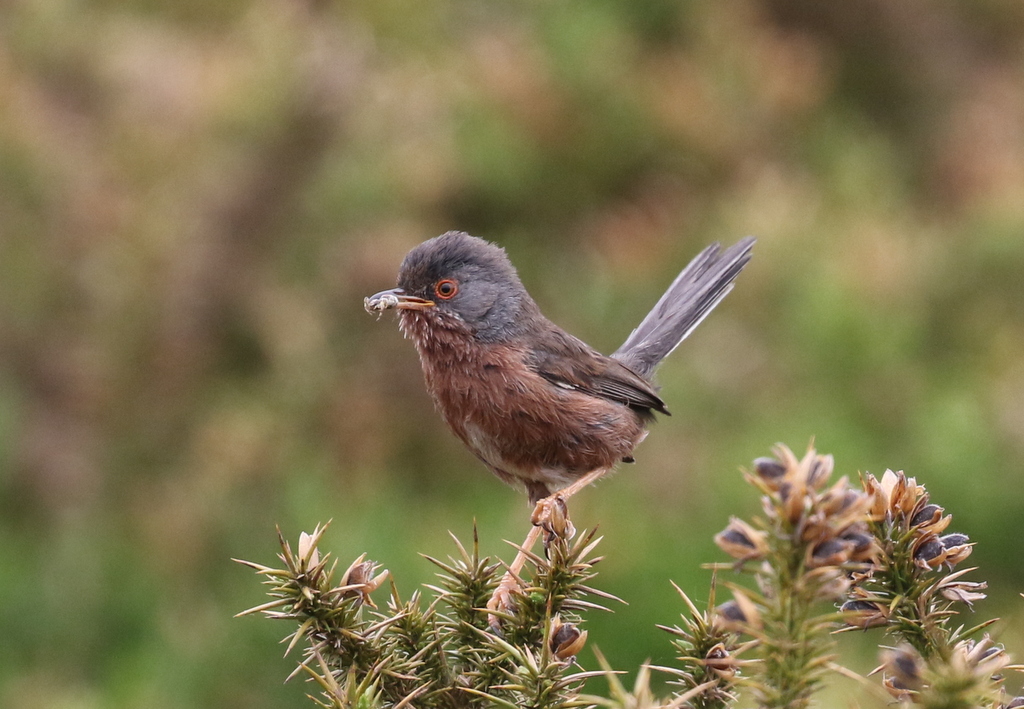
While we were watching the Dartford Warblers, a Nightjar churred from the trees beyond. A bit of a surprise – they are mainly nocturnal, but sometimes one will churr briefly during the day. We left the Dartford Warblers in peace to carry on with their feeding duties, and carried on across the Heath.
It had all gone fairly quiet again, until we turned a corner out from some thick gorse into a more open area and looked across to see a pair of Woodlarks flying towards us. They flew straight past over our heads, before one turned and landed in an area of short heather behind us. We walked over and could see it creeping around in the vegetation. It was presumably the female, as we could hear the male singing quietly from some trees very close by.
The male Woodlark then dropped down to the ground to join the female, and we watched them both for a while walking around and feeding. Eventually, the male flew up onto a nearby fence post and started calling. Then they both flew up over the trees and were lost to view.
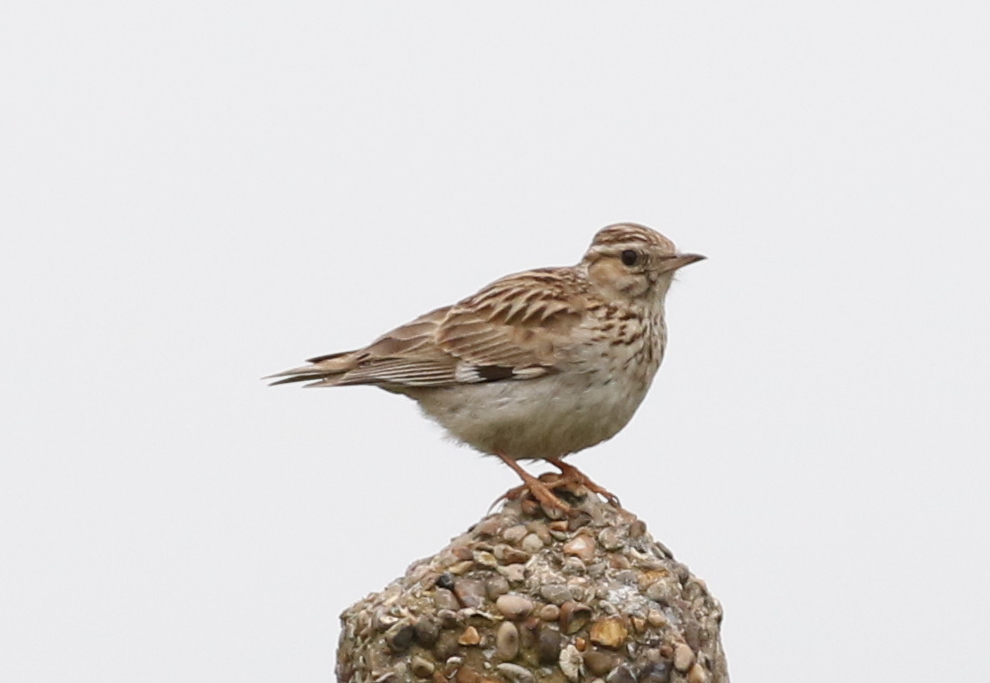
It was great to get such fantastic views of the two main target species up on the Heath – our afternoon visit had really paid off today! We headed round to check up on the pair of Stonechats. They were a bit harder to see at first, but then we heard the male singing, and found him hiding in the top of a young oak.
The cloud had lifted and it had started to brighten up now. There was still enough time to squeeze in one more stop this afternoon, so we made our way back to the car and drove down to Cley. We parked at the end of the East Bank, and set out along it. Looking back, we could see a couple of drake Common Pochard on the pool on the other side of road. The pair of Mute Swans on Don’s Pool now have four cygnets, and a Grey Heron had taken over their nest as a convenient place to preen. There were a couple of Tufted Duck on the water here too.
When we heard a Bearded Tit calling, we turned to get a quick flight view as one zipped across the top of the reeds and dropped back in. Two of three Marsh Harriers were circling up over the back of the reedbed, and we noticed one of the males flying in carrying something in its talons. The female circled up below and the male dropped the food for her to catch, a ‘food pass’.

There were still one or two Lapwings and Redshank displaying out on the grazing marsh. A few ducks were swimming round on the Serpentine or lurking around the grassy edges – mostly Shelducks, Mallard, Gadwall and Shoveler. More unseasonal was the lingering lone drake Wigeon and three Teal. Almost all of the ones which were here over the winter have long since departed north for the breeding season.
The side of the East Bank, covered in flowers, was alive with insects in the afternoon sun. In particular, there were lots of migrant Silver Y moths buzzing round, as well as a couple of Common Blue butterflies. One or two Four-spotted Chasers patrolled the edge of the ditch the other side.
Out at Arnold’s Marsh, a few Sandwich Terns had gathered out on the shingle island at the back, along with a couple of Little Terns. There were a few waders on here too. A pair of Little Ringed Plovers were down at the front, the female on the nest. A single Bar-tailed Godwit was out at the back, along with two Dunlin and a Ringed Plover. A male Wheatear was a nice surprise, on one of the gravel spits over towards one side.
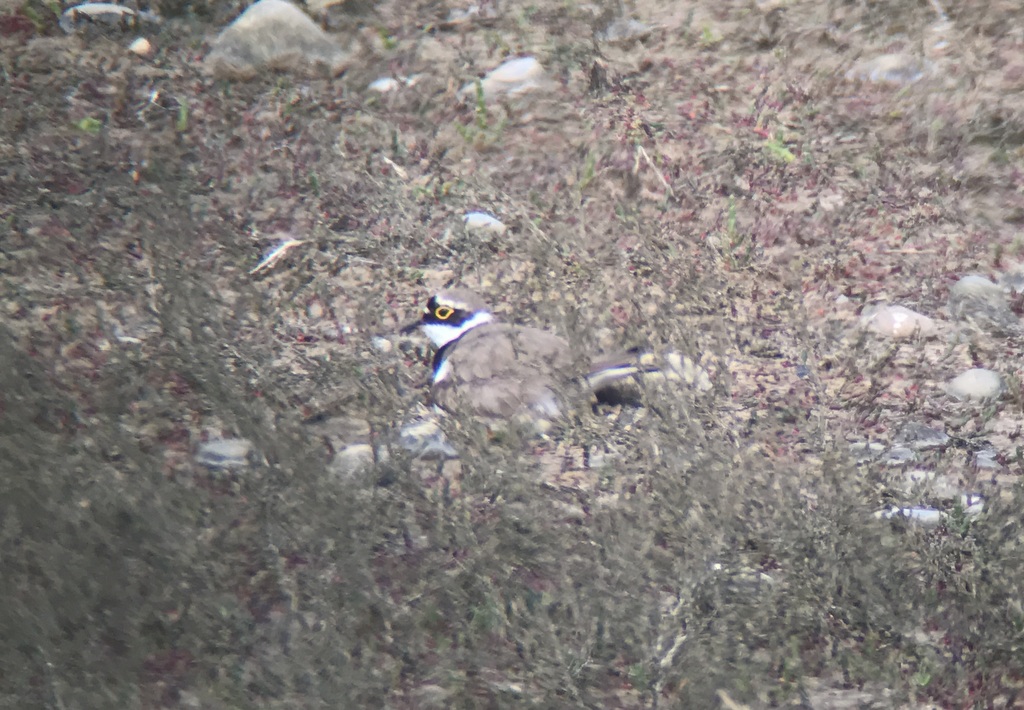
You can’t come all this way without visiting the beach, but it was a bit misty offshore still. A few more Sandwich Terns were flying back and forth, and we saw two Common Terns too.
On the walk back, a Grey Plover had now appeared on Arnolds, and what looked like a second Wheatear, a more richly coloured bird. A Curlew flew in over the grazing marsh and headed off west and a Common Sandpiper was now bathing on the edge of the Serpentine with a Ringed Plover for company. Two Mediterranean Gulls flew over calling.
It was time to head for home. On the drive back, a Red Kite was circling over the fields beside the road, a nice late addition to the day’s list. Let’s see what tomorrow brings too!
















